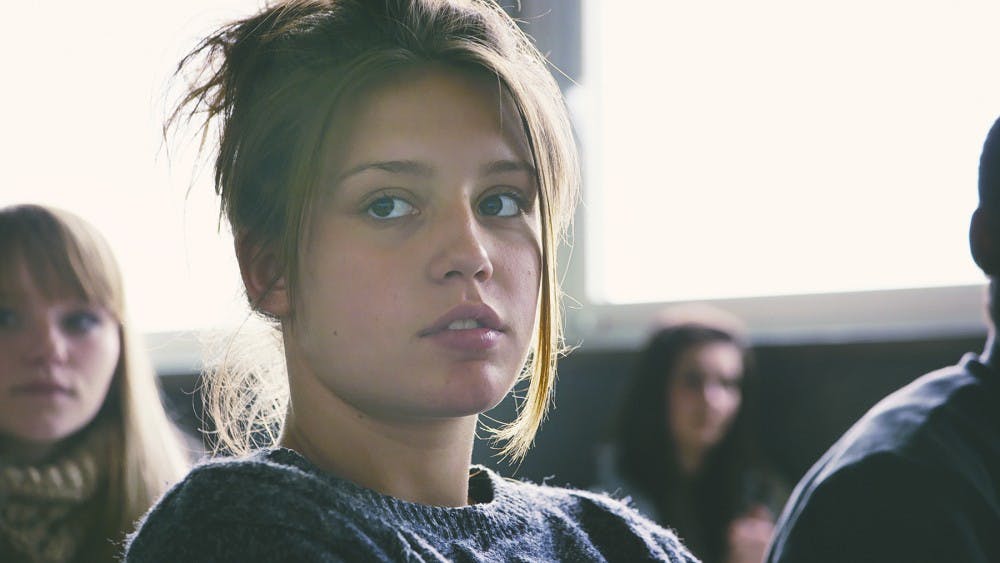France’s lesbian drama is the best film of 2013, one of the best ever made
The French NC-17-rated romantic drama “Blue Is the Warmest Color,” really has no plot, or at least very little happens in the three-hour story.
The film, the original title of which translates to “The Life of Adèle – Chapters 1 and 2,” follows the life of Adèle (Adèle Exarchopoulos) as she starts high school. She has full, round cheeks, a slightly agape mouth and a longing curiousness in her eyes.
There is not yet great pain or frustration in her life for the most part. Rather, she is a typical teenager trying to find her place in the world. She becomes friendly with an attractive boy she goes to school with, and their relationship continues with meals and conversation.
On the way to meet him one day, she sees a woman with blue hair with her arms around another woman. She instantly catches Adèle’s eye, even among the crowd in the bustling city street. Adèle continues dating her boyfriend, and like many teenage relationships, it becomes sexual. Unmoved by her first time at intercourse, she realizes not so much that she is a lesbian yet, but that she does not seem to be attracted to men. Her heterosexual experience leaves her cold and detached.
One of Adèle’s best male friends is gay, and one evening, he takes her to a gay nightclub. She slips out and finds her way into a lesbian bar, and much to her surprise, she sees the blue-haired woman she saw briefly on the street.
She finds out her name is Emma (Léa Seydoux), and the two have a long conversation at the bar. Right away, they both can tell they have a connection. They begin seeing each other as friends, but their relationship quickly blossoms into rapturous, sensual love.
“Blue Is the Warmest Color” won the Palme d’Or at last year’s Cannes Film Festival, and in an unprecedented move, the award was given to not only its director, Abdellatif Kechiche, but also to its two female stars, Adèle Exarchopoulos and Léa Seydoux. It is the best film of 2013.
There have been few films ever made that have been as emotionally raw and honest about love, sex and human attraction as this one is.
Because there is no real narrative to the film, the viewer is asked to completely invest in the characters. Most of the film is shot in medium close-up with hand-held cameras giving the film a spontaneous power. The viewer almost becomes a part of the relationship because of its intimacy. The film does not seem to be made to satisfy an audience or tell a conventional story. Some of the conversations go on for much longer than they would in most films, and the characters pause and glance like actual people do.
Kechiche let the actresses read his script only once and wanted them to forget their lines and react naturally together. The film is a character study that is so invested in its characters that it truly feels like real life is unfolding.
The actresses are committed to their performances, and they pour their souls onto the screen. Some of the most emotional scenes are hard to watch because the characters’ intensity is so palpable and fierce. Much has been made about the explicit sex scenes in the film that earned it the NC-17 rating.
They are graphic, but everything was simulated. Some people have criticized the film for being voyeuristic because a straight male director is leering at the private life of these woman.
However, the director is capturing the intellectual, emotional and physical connection the two women have for each other, and the sex scenes are an essential piece of the rest of the film. The scenes of lovemaking, as graphic as they are, are vital in creating the bond between Adèle and Emma.
“Blue Is the Warmest Color” is as awe-inspiring and cinema-redefining in its intimacy as Alfonso Cuarón’s “Gravity” is in its grandeur.
It is one of the cinema’s best love stories, regardless of the characters’ sexuality. There are moments and images in the film, glimpses into other lives, that are as beautiful and moving as anything ever put on screen.

